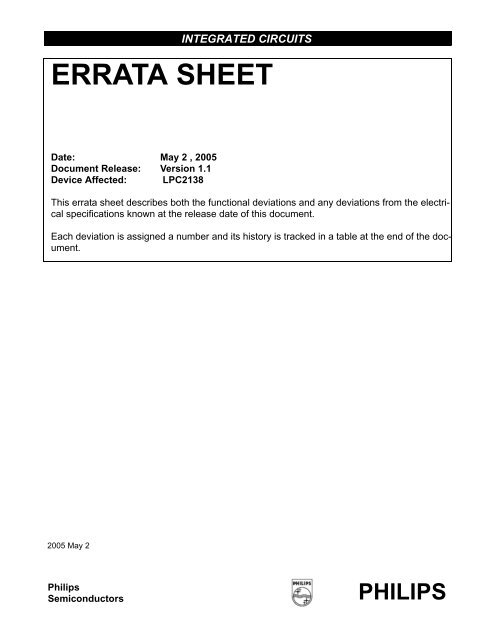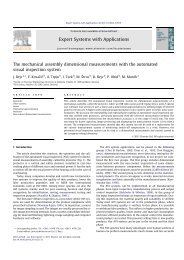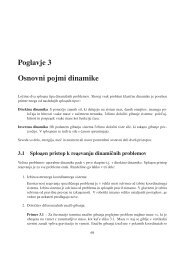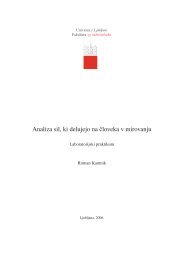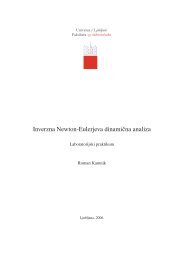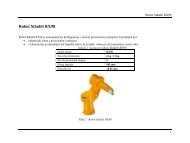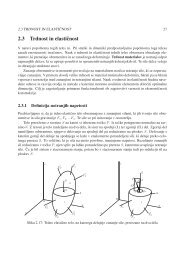ERRATA SHEET
ERRATA SHEET
ERRATA SHEET
Create successful ePaper yourself
Turn your PDF publications into a flip-book with our unique Google optimized e-Paper software.
INTEGRATED CIRCUITS<br />
<strong>ERRATA</strong> <strong>SHEET</strong><br />
Date: May 2 , 2005<br />
Document Release: Version 1.1<br />
Device Affected: LPC2138<br />
This errata sheet describes both the functional deviations and any deviations from the electrical<br />
specifications known at the release date of this document.<br />
Each deviation is assigned a number and its history is tracked in a table at the end of the document.<br />
2005 May 2<br />
Philips<br />
Semiconductors<br />
PHILIPS
Philips Semiconductors<br />
LPC2138 Erratasheet<br />
Identification:<br />
The LPC2138 devices typically have the following top-side marking:<br />
LPC2138xxx<br />
xxxxxxx<br />
xxYYWW R<br />
The last letter in the third line (field ‘R’) will identify the device revision. This Errata Sheet covers the following<br />
revisions of the LPC2138:<br />
Revision Identifier (R)<br />
- Initial device revision<br />
‘A’<br />
Second device revision<br />
Comment<br />
Field ‘YY’ states the year the device was manufactured. Field ‘WW’ states the week the device was manufactured<br />
during that year.<br />
Functional Deviations of LPC2138<br />
Core.1<br />
Introduction:<br />
Problem:<br />
Work around:<br />
Incorrect update of the Abort Link register in Thumb state<br />
If the processor is in Thumb state and executing the code sequence STR, STMIA or PUSH followed<br />
by a PC relative load, and the STR, STMIA or PUSH is aborted, the PC is saved to the abort link<br />
register.<br />
In this situation the PC is saved to the abort link register in word resolution, instead of half-word<br />
resolution.<br />
Conditions:<br />
The processor must be in Thumb state, and the following sequence must occur:<br />
<br />
Philips Semiconductors<br />
LPC2138 Erratasheet<br />
TIMER.1<br />
Introduction:<br />
Problem:<br />
Missed Interrupt Potential<br />
The Timers may be configured so that events such as Match and Capture, cause interrupts. Bits in<br />
the Interrupt Register (IR) indicate the source of the interrupt, whether from Capture or Match.<br />
If more than one interrupt for multiple Match events using the same Timer are enabled, it is possible<br />
that one of the match interrupts may not be recognized. If this occurs no more interrupts from that<br />
specific match register will be recognized. This could happen in a scenario where the match events<br />
are very close to each other. This issue also affects the Capture functionality.<br />
Specific details:<br />
Suppose that two match events are very close to each other (Say Match0 and Match1). Also<br />
assume that the Match0 event occurs first. When the Match0 interrupt occurs the 0th bit of the<br />
Interrupt Register will be set. To exit the Interrupt Service Routine of Match0, this bit has to be<br />
cleared in the Interrupt Register. The clearing of this bit might be done by using the following<br />
statement:<br />
T0_IR = 0x1;<br />
It is possible that software will be writing a 1 to bit 0 of the Interrupt Register while a Match1 event<br />
occurs, meaning that hardware needs to set the bit 1 of the Interrupt Register. In this case, since<br />
hardware is accessing the register at the same time as software, bit 1 for Match1 never gets set,<br />
causing the interrupt to be missed.<br />
In summary, while software is writing to the Interrupt Register, any Match or Capture event (which<br />
are configured to interrupt the core) occurring at the same time may result in the subsequent<br />
interrupt not being recognized.<br />
Similarly for the Capture event, if a capture event occurs while a Match event is being is serviced<br />
then the Capture event might be missed if the software and hardware accesses coincide.<br />
Affected features:<br />
1. Interrupt on Match for Timer0/1.<br />
2. Interrupt on Capture for Timer0/1.<br />
3. These same features will be affected when using PWM.<br />
Work-around:<br />
There is no clear workaround for this problem but some of the below mentioned solutions could<br />
work with some applications.<br />
Possible workarounds for Match functionality:<br />
1. If the application only needs two Match registers then distribute them between Timer 0 and<br />
Timer 1 to avoid this problem.<br />
2. Stop the timer before accessing the Interrupt register for clearing the interrupt and then start timer<br />
again after the access is completed.<br />
3. Polling for interrupt: Supposing that there are two Match events (Match X and Match Y). At the<br />
end of the Interrupt Service Routine (ISR) for Match X, compare the Timer Counter value with the<br />
Match Register Y value. If the Timer Counter value is more than the Match Register Y value then<br />
it is possible that this event might have been missed. In this case jump to the ISR directly and<br />
service Match event Y.<br />
2005 May 2 3
Philips Semiconductors<br />
LPC2138 Erratasheet<br />
Possible workarounds for Capture functionality:<br />
1. Try to spread the capture events between both timers if there are two capture events. If the<br />
application also has a match event then one of the capture events may suffer.<br />
2. Polling for Capture: At the end of a Match interrupt ISR or Capture event ISR compare the<br />
previous Capture value with the current Capture value. If the Capture value has changed then<br />
the Capture event might have been missed. In this case, jump to the ISR directly and service the<br />
Capture event.<br />
PWM.1<br />
Missed Interrupt Potential for the Match functionality. The description is same as above.<br />
Power Down.1: Restricted Vdd while device is in power down mode.<br />
Introduction: This device has two reduced power modes: idle mode and power down mode. In power down<br />
mode, the oscillator is shut down and the chip receives no internal clocks.<br />
Problem: If Vdd is below the specified value, a reset could occur, waking up the device and the saved values<br />
in SRAM will be re initialized according to a power-up procedure.<br />
Work-around: The two possible workarounds would be:-<br />
1. Avoid operating in power down mode.<br />
2. If the device is operated in power down mode then Vdd should be 3.3V +10%/-5%.<br />
Brown-out Detection(BOD).1: BOD reset does not get triggered when the voltage of Vdd falls below 2.6V<br />
Introduction: The BOD monitors the Vdd in two stages. If the voltage falls below 2.9 V, the BOD asserts an<br />
interrupt signal to the Vectored Interrupt Controller. The second stage of the low voltage detection<br />
asserts Reset to inactivate the device when Vdd falls below 2.6V.<br />
Problem: BOD reset does not get triggered when the voltage of Vdd falls below 2.6V.<br />
Work-around: Use the interrupt at 2.9V to drive the device into a save status.<br />
UART.1<br />
Introduction:<br />
Problem:<br />
Coinciding VPB read and hardware register update.<br />
Reading the contents of the IIR,LSR and MSR registers will clear certain bits in the register.<br />
1. Reading the IIR should clear the THRE status if THRE is the highest priority pending interrupt<br />
(Only affects UART1).<br />
2. Reading LSR should clear the OE/PE/FE/BI bits (affects both UART0 and UART1).<br />
3. Reading MSR should clear the Delta DCD/Trailing Edge RI/Delta DSR/Delta CTS bits (Only<br />
affects UART1).<br />
If hardware is setting one of these above bits while the software is reading the contents of the<br />
register the reading process clears all bits in the register including the bit that got set by hardware.<br />
The software reads the old value though and the bit that got set by hardware is lost.<br />
Specific details:<br />
Suppose IIR has a modem status interrupt while the other interrupts are inactive and software reads<br />
the IIR value (polling) while hardware sets the THRE interrupt then software will read the Modem<br />
Interrupt value while the THRE interrupt is cleared i.e the THRE interrupt is lost.<br />
Suppose the LSR is all zeros and software is reading the register while hardware is generating a<br />
parity error then the parity error bit is cleared while the software reads the old value (all zeros) i.e.<br />
2005 May 2 4
Philips Semiconductors<br />
LPC2138 Erratasheet<br />
Work-around:<br />
the parity error is lost.<br />
Suppose MSR is all zeros and software is polling the value of the register while the value of CTS is<br />
changing then the change in CTS value should result in the Delta CTS bit getting set. Instead<br />
software will read all zeros and the Delta CTS bit in the MSR register will be cleared i.e. the Delta<br />
CTS status is lost.<br />
IIR reading:<br />
The IIR bug can be worked around by disabling the modem status interrupt effectively making<br />
THRE the lowest priority interrupt. The work-around does not work in software interrupt polling<br />
mode. Modem status has to be handled by software polling MSR.<br />
Now there are two cases:<br />
1. A THRE interrupt is pending, software responds to the interrupt by reading the IIR while another,<br />
higher priority interrupt is set (e.g. RDA). In this case software will read the THRE status although<br />
the status will not be cleared where it should have been. After handling the THRE and RDA interrupt<br />
another dummy THRE interrupt may occur, unless in the meantime software has filled THR. This is<br />
considered an error although not fatal.<br />
2. A high priority interrupt is pending, software responds to the interrupt by reading the IIR register<br />
while a THRE interrupt is set. In this case, software will read the higher priority interrupt and the<br />
THRE interrupt will be handled later. This behaviour is as expected.<br />
LSR reading:<br />
A work-around for this problem is to service the OE/PE/FE/BI condition before another character is<br />
received which will trigger an LSR update. So basically, service the interrupt in one-character time.<br />
MSR reading:<br />
The MSR bug can be worked-around by not using the Delta DCD/Trailing Edge RI/Delta DSR/Delta<br />
CTS bits in the MSR but instead use the DCD/TRI/DSR/CTS bits in the same register. To prevent,<br />
a transition from being missed software should poll the register’s value at a sufficiently high rate.<br />
Note.1:<br />
Introduction:<br />
Increased power consumption from battery while RTC is running from the main 3.3V supply<br />
The RTC is powered by its own power supply pin, Vbat, which can be connected to a battery or to<br />
the same 3.3 volt supply used by the rest of the device.<br />
Problem:<br />
If the VBAT is connected to an external battery, RTC will consume more power from the battery if<br />
the core is running and the selected clock sourceis the prescaler.<br />
Work-around:<br />
Switch the clock source such that the RTC takes the clock from the 32 KHz oscillator that is<br />
connected to the RTCX1 and RTCX2 pins. After initialization of the RTC, clear the PCRTC bit in the<br />
PCONP register to switch off the peripheral clock (pclk) to RTC. Any further writes to the RTC would<br />
require this bit to be set.This will reduce the power consumed from VBAT.<br />
Note.2:<br />
Port pin P0.31 must not be driven low during reset. If low on reset the device behaviour is<br />
undetermined.<br />
2005 May 2 5
Philips Semiconductors<br />
LPC2138 Erratasheet<br />
Errata History - Functional Problems<br />
Functional<br />
Problem<br />
Short Description<br />
Errata occurs in<br />
device revision<br />
Core.1 Incorrect update of the Abort link register -, A<br />
Timer.1 Missed Interrupt Potential -, A<br />
PWM.1 Missed Interrupt Potential for Match Functionality -, A<br />
Power Down.1 Restricted Vdd while device is in power down mode A<br />
BOD.1 BOD reset not functional -<br />
UART.1 Coinciding VPB read and hardware register update -, A<br />
2005 May 2 6


